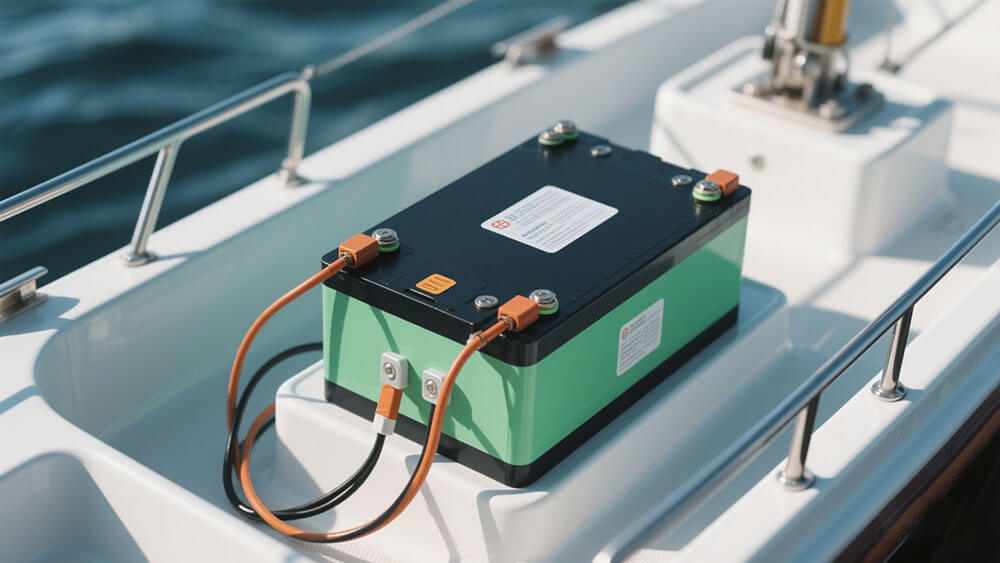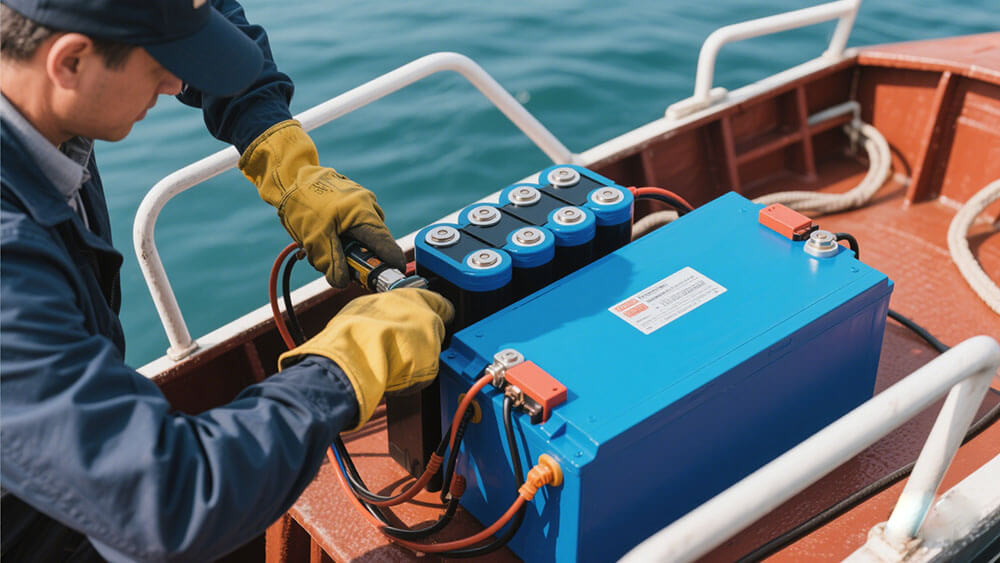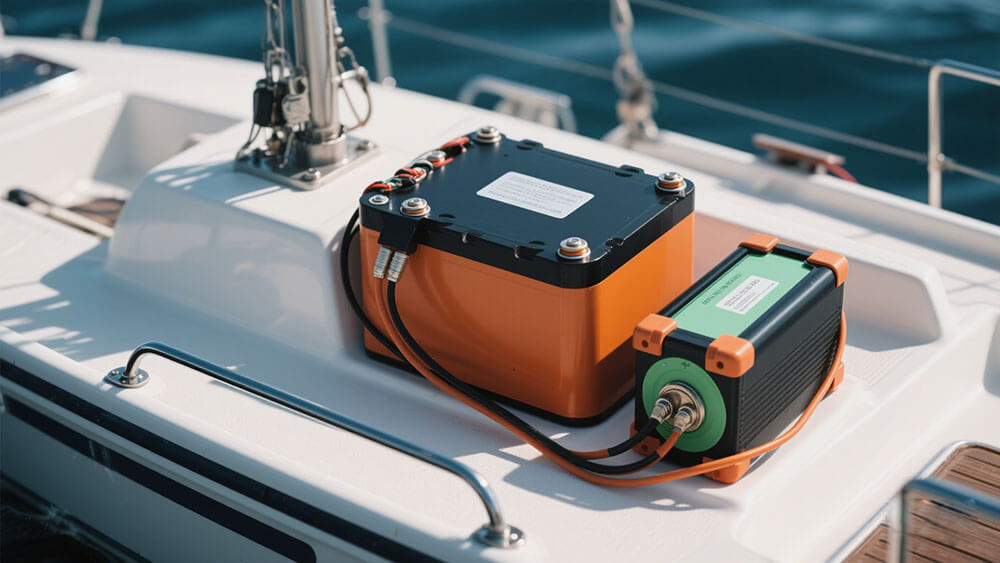Contents

Maintaining your boat lithium battery ensures optimal performance, safety, and longevity. Proper care extends its lifespan to 8-10 years, outperforming lead-acid batteries’ 2-3 years. By avoiding full discharges and extreme temperatures, you can achieve up to 5,000 cycles, reducing costs and ensuring reliable operation during your maritime adventures.
Key Takeaways
Charge your boat’s lithium battery after every use. This keeps it working well and lasting longer.
Keep your battery in a cool, dry spot with 40-50% charge. This stops it from wearing out and keeps it ready to use.
Check your battery often for damage and check its voltage. Finding problems early can save money and keep it safe.

Part 1: Understanding Boat Lithium Batteries
1.1 Why Lithium Batteries Are Ideal for Marine Use
Lithium batteries, particularly LiFePO4 Lithium batteries, have revolutionized energy storage in marine environments. Their advanced chemical composition ensures safety by minimizing the risk of overheating, a critical factor for boats operating in varying conditions. Designed specifically for marine use, these batteries excel in durability and reliability. They offer faster charging, higher power density, and longer battery life compared to traditional options. For instance, LiFePO4 batteries can handle up to 5,000 cycles with a depth of discharge reaching 100% without compromising capacity. This makes them a superior choice for maintaining lithium batteries in boats.
Moreover, their lightweight design reduces the overall weight of the vessel, improving fuel efficiency and performance. These features make lithium batteries indispensable for marine applications, where reliability and efficiency are paramount.
1.2 Key Features of Boat Lithium Battery
Boat lithium batteries are engineered to meet the demanding requirements of marine environments. Large Power boast high energy efficiency, with charge acceptance rates exceeding 95%. This ensures optimal performance even under heavy loads. Lithium-ion batteries, for example, provide significant improvements in energy systems for house loads on boats. Their ability to deliver consistent power output enhances operational efficiency, reducing the cost of energy production onboard.
Additionally, these batteries are virtually maintenance-free, eliminating the need for regular checks and cleaning. Their robust design withstands vibrations and shocks, ensuring longevity. The integration of advanced battery management systems (BMS) further enhances safety by monitoring capacity, voltage, and temperature in real time.
1.3 Advantages Over Lead-Acid Batteries
Lithium batteries outperform lead-acid batteries in every critical metric. The table below highlights their comparative advantages:
Feature | Lithium Batteries | Lead-Acid Batteries |
|---|---|---|
Efficiency | 95%+ | 80-85% |
Lifespan (Cycles) | 3,000 – 5,000 | 500 – 1,000 |
Weight | 50-70% lighter | Heavier |
Charging Time | 1 – 5 hours | 6 – 12 hours |
Maintenance | None | High |
Depth of Discharge | Up to 100% | Recommended max 50% |
These advantages translate to reduced operational costs and enhanced reliability, making lithium batteries the preferred choice for marine applications. By investing in lithium technology, you ensure better performance and longer-lasting energy solutions for your boat.

Part 2: Best Practices for Maintaining Boat Lithium Batteries
2.1 Charging Guidelines for Optimal Performance
Proper charging practices are essential for maintaining lithium batteries and ensuring their longevity. To optimize performance, follow these guidelines:
Charge After Each Use: Avoid deep discharges by recharging your boat lithium battery after every use. This practice helps maintain capacity and extends battery life.
Use a Compatible Charger: Always use a charger specifically designed for lithium batteries. Incompatible chargers can damage the battery’s internal components and reduce its efficiency.
Avoid Overcharging: Do not charge to 100% SOC (state of charge) unless necessary. Keeping the charge level between 20% and 80% is ideal for preserving battery health.
Monitor Temperature During Charging: Extreme temperatures can affect charging efficiency. Ensure the battery remains within the recommended temperature range (typically 0°C to 45°C) during the process.
Leverage Advanced Charging Techniques: Utilize chargers with Battery Management Systems (BMSs) to monitor and optimize charging parameters. These systems prevent overcharging and overheating, ensuring safety and efficiency.
By adhering to these charging practices, you can maximize the performance and lifespan of your boat lithium battery.
2.2 Proper Storage Conditions
Storing your boat lithium battery correctly is crucial for maintaining its capacity and preventing degradation. Follow these best practices:
Store in a Cool, Dry Place: Avoid environments with extreme temperatures or high humidity. Heat accelerates chemical degradation, while moisture can lead to corrosion.
Maintain Partial Charge: For long-term storage, keep the battery at a 40–50% charge state. This minimizes stress on the battery cells and prevents overcharging or deep discharges.
Avoid Direct Sunlight: Prolonged exposure to sunlight can cause overheating and physical damage, such as swelling or leakage.
Regularly Check Charge Levels: Periodically inspect the battery’s charge level during storage. Recharge to about 50% if the charge drops below this threshold.
Proper storage conditions not only extend battery life but also ensure reliable performance when the battery is reactivated.
2.3 Cleaning and Preventing Corrosion
Corrosion can compromise the efficiency and safety of your boat lithium battery. Regular cleaning and preventive measures are essential:
Clean Terminals Regularly: Use a soft cloth and a mild cleaning solution to remove dirt and debris from the battery terminals. This ensures a clean connection and efficient charging.
Apply Anti-Corrosion Spray: Protect the terminals by applying a specialized anti-corrosion spray. This prevents oxidation and extends the battery’s lifespan.
Inspect for Signs of Corrosion: Look for discoloration or buildup around the terminals. Address any issues promptly to avoid further damage.
By keeping the battery clean and taking steps to prevent corrosion, you can maintain its capacity and ensure safe operation.
2.4 Regular Inspections and Monitoring
Routine inspections are vital for identifying potential issues before they escalate. Incorporate these practices into your maintenance routine:
Check for Physical Damage: Inspect the battery for signs of swelling, leakage, or cracks. Physical damage can compromise safety and performance.
Monitor Voltage and Capacity: Use a multimeter or a BMS to track the battery’s voltage and capacity. Significant drops may indicate underlying issues.
Update Firmware: For smart lithium batteries, ensure the firmware is up to date. Updates often include improvements to battery management and safety features.
Regular monitoring helps you address problems early, ensuring the battery remains in optimal condition.
2.5 Balancing Battery Cells for Longevity
Balancing the cells within your boat lithium battery is critical for maintaining uniform capacity and extending battery life. Here’s how you can achieve this:
Utilize a Battery Management System: A BMS automatically balances the cells by redistributing charge, ensuring all cells operate at the same voltage level.
Perform Manual Balancing if Necessary: In cases where the BMS is unavailable, use a balancing charger to equalize the cells.
Monitor Cell Health: Regularly check the voltage of individual cells. Significant imbalances may indicate a need for professional servicing.
Balanced cells ensure consistent performance and prevent premature wear, maximizing the battery’s lifespan.

Part 3: Avoiding Common Mistakes
3.1 Using Incompatible Chargers
Using the wrong charger can severely impact the performance and safety of your boat lithium battery. Chargers designed for lead-acid batteries or other chemistries may not align with the specific requirements of lithium-ion batteries. This mismatch can lead to overcharging, overheating, or even permanent damage to the battery cells. Always ensure the charger is compatible with your battery type and includes features like voltage regulation and temperature monitoring. A charger with a built-in Battery Management System (BMS) is ideal for maintaining lithium batteries, as it optimizes charging parameters and prevents potential risks.
3.2 Exposing Batteries to Extreme Temperatures
Temperature extremes can significantly affect battery life and performance. Cold weather slows discharge rates and reduces capacity, while extreme heat accelerates wear and shortens lifespan. For instance:
Low temperatures can cause lithium plating, leading to dendrite formation and potential short circuits.
High temperatures increase chemical reaction rates, causing faster aging and thermal runaway risks.
A 6-10°C rise in temperature can halve the battery’s lifespan due to overcharge accumulation.
To avoid these issues, store and operate your battery within the recommended temperature range. Use thermal management systems to maintain optimal conditions, especially in challenging marine environments.
3.3 Neglecting Regular Maintenance
Skipping routine maintenance can lead to unexpected failures and costly repairs. Regularly inspect your battery for physical damage, such as swelling or cracks, and clean the terminals to prevent corrosion. Monitor voltage and capacity using a multimeter or BMS to identify potential issues early. These best practices for maintaining lithium batteries ensure consistent performance and extend their lifespan.
3.4 Overcharging or Deep Discharging
Overcharging and deep discharging are two of the most common mistakes that reduce battery life. Overcharging can cause lithium metal formation, leading to short circuits and overheating. Deep discharging, on the other hand, stresses the battery cells and reduces their capacity over time. To prevent these issues:
Avoid charging the battery to 100% unless necessary.
Keep the charge level between 20% and 80% for optimal performance.
Use a charger with overcharge protection to enhance safety.
By following these guidelines, you can protect your battery from premature wear and ensure reliable operation.
Maintaining your boat lithium battery is essential for safety, performance, and extending battery life. Follow best practices like regular inspections, proper charging, and safe storage. These steps ensure reliability and reduce costs. For tailored solutions from Large Power, consult experts to address your specific needs and maximize your battery’s potential.
Tip: Regular testing and safe handling enhance battery efficiency and longevity.
FAQ
1. How do you prepare a lithium battery for long term storage?
Store the battery at 40–50% charge in a cool, dry place. Avoid extreme temperatures and periodically check the charge level to maintain optimal condition.
2. What is the best way to monitor battery capacity?
Use a Battery Management System (BMS) or a multimeter to track voltage and capacity. Regular monitoring ensures consistent performance and prevents unexpected failures.
Tip: For professional guidance on Battery Management System(BMS) , visit Large Power.
3. Can lithium batteries be used in extreme weather conditions?
Yes, but you must operate them within the recommended temperature range. Extreme heat or cold can reduce capacity and shorten the battery’s lifespan.





